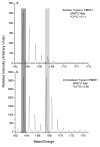Minimizing back exchange in 18O/16O quantitative proteomics experiments by incorporation of immobilized trypsin into the initial digestion step
- PMID: 17249691
- PMCID: PMC2796076
- DOI: 10.1021/ac0620819
Minimizing back exchange in 18O/16O quantitative proteomics experiments by incorporation of immobilized trypsin into the initial digestion step
Abstract
Differential labeling of peptides via the use of the 18O-water proteolytic labeling method has been widely adopted for quantitative shotgun proteomics studies due to its simplicity and low reagent costs. In this report, the use of immobilized trypsin in the initial digestion step, in addition to the initial digestion step, is explored as a means to minimize postlabeling back exchange of 18O-labeled peptides into the 16O form when multidimensional peptide separation methods (here, isoelectric focusing of peptides) are incorporated into the sample workflow. Examples are shown with a mixture of standard proteins and a sample from an ongoing clinical proteomics study.
Figures

Similar articles
-
Proteolytic labeling with 18O for comparative proteomics studies: preparation of 18O-labeled peptides and the 18O/16O peptide mixture.Methods Mol Biol. 2007;359:135-42. doi: 10.1007/978-1-59745-255-7_9. Methods Mol Biol. 2007. PMID: 17484115
-
A simple procedure for effective quenching of trypsin activity and prevention of 18O-labeling back-exchange.J Proteome Res. 2009 May;8(5):2157-63. doi: 10.1021/pr800971w. J Proteome Res. 2009. PMID: 19222237 Free PMC article.
-
Quantitative protein analysis using enzymatic [¹⁸O]water labeling.Curr Protoc Protein Sci. 2014 Apr 1;76:23.4.1-23.4.9. doi: 10.1002/0471140864.ps2304s76. Curr Protoc Protein Sci. 2014. PMID: 24692014 Free PMC article. Review.
-
Production of 18O-single labeled peptide fragments during trypsin digestion of proteins for quantitative proteomics using nanoLC-ESI-MS/MS.J Proteome Res. 2010 Jul 2;9(7):3741-9. doi: 10.1021/pr900865p. J Proteome Res. 2010. PMID: 20496949
-
Proteolytic 18O-labeling strategies for quantitative proteomics.Mass Spectrom Rev. 2007 Jan-Feb;26(1):121-36. doi: 10.1002/mas.20116. Mass Spectrom Rev. 2007. PMID: 17086517 Review.
Cited by
-
18O stable isotope labeling in MS-based proteomics.Brief Funct Genomic Proteomic. 2009 Mar;8(2):136-44. doi: 10.1093/bfgp/eln055. Epub 2009 Jan 16. Brief Funct Genomic Proteomic. 2009. PMID: 19151093 Free PMC article. Review.
-
High efficiency and quantitatively reproducible protein digestion by trypsin-immobilized magnetic microspheres.J Chromatogr A. 2012 Jan 13;1220:68-74. doi: 10.1016/j.chroma.2011.11.050. Epub 2011 Dec 2. J Chromatogr A. 2012. PMID: 22176736 Free PMC article.
-
Differential membrane proteomics using 18O-labeling to identify biomarkers for cholangiocarcinoma.J Proteome Res. 2008 Nov;7(11):4670-7. doi: 10.1021/pr800215n. Epub 2008 Oct 8. J Proteome Res. 2008. PMID: 18839982 Free PMC article.
-
18O labeling over a coffee break: a rapid strategy for quantitative proteomics.J Proteome Res. 2008 Jul;7(7):3042-8. doi: 10.1021/pr800018g. Epub 2008 May 30. J Proteome Res. 2008. PMID: 18510357 Free PMC article.
-
Statistical model to analyze quantitative proteomics data obtained by 18O/16O labeling and linear ion trap mass spectrometry: application to the study of vascular endothelial growth factor-induced angiogenesis in endothelial cells.Mol Cell Proteomics. 2009 May;8(5):1130-49. doi: 10.1074/mcp.M800260-MCP200. Epub 2009 Jan 29. Mol Cell Proteomics. 2009. PMID: 19181660 Free PMC article.
References
-
- Goodlett DR, Yi EC. Trends Analyt Chem. 2003;22:282–+.
-
- Julka S, Regnier F. J Proteome Res. 2004;3:350–363. - PubMed
-
- Gygi SP, Rist B, Gerber SA, Turecek F, Gelb MH, Aebersold R. Nat Biotechnol. 1999;17:994–999. - PubMed
-
- Li J, Steen H, Gygi SP. Mol Cell Proteomics. 2003;2:1198–1204. - PubMed
-
- Goshe MB, Smith RD. Curr Opin Biotechnol. 2003;14:101–109. - PubMed
Publication types
MeSH terms
Substances
Grants and funding
LinkOut - more resources
Full Text Sources

